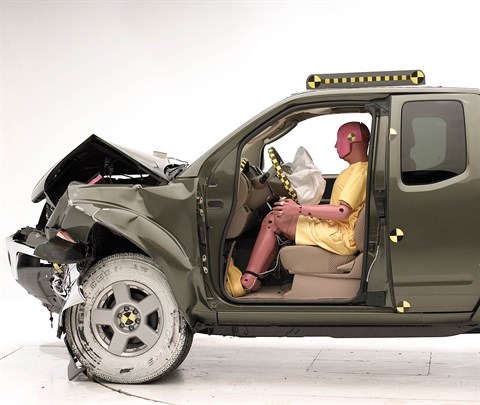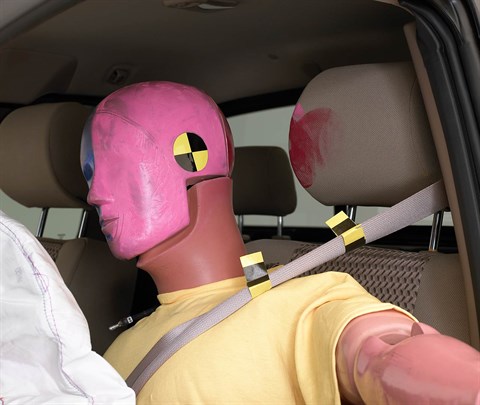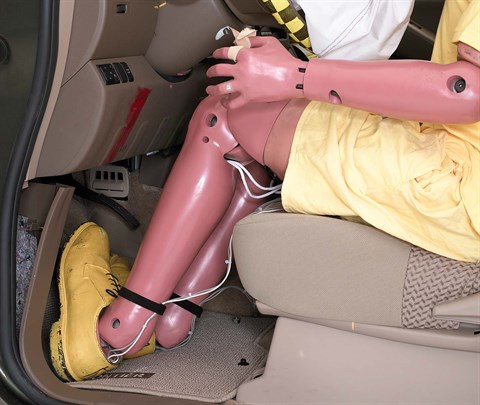Moderate overlap front: original test
Rating applies to 2009-12 models
Tested vehicle: 2008 Nissan Frontier SE Crew Cab
The Nissan Frontier Crew Cab and King Cab were redesigned for the 2005 model year and are significantly larger and heavier than previous models. The Suzuki Equator Crew Cab and Extended Cab were introduced in the 2009 model year. Two tests of the Frontier were conducted, one by the Institute of a 2wd King Cab and the other by Nissan of a 2wd Crew Cab. The overall rating of Good is based on review of both tests, which independently result in overall ratings of Good. The ratings and vehicle specifications based on Nissan's test are shown below because the 2wd Crew Cab is similar to the configuration of other pickups tested more recently.
| Evaluation criteria | Rating |
|---|---|
| Overall evaluation | |
| Structure and safety cage | |
| Driver injury measures | |
| Head/neck | |
| Chest | |
| Leg/foot, left | |
| Leg/foot, right | |
| Driver restraints and dummy kinematics | |

Action shot taken during the Institute's frontal offset crash test.

The dummy's position in relation to the steering wheel and instrument panel after the crash test indicates that the driver's survival space was maintained well (Institute test vehicle shown).

Dummy movement was well controlled in both tests. During rebound, the dummy's head hit only the head restraint.

In both tests, forces on the left knee and the right lower leg were high enough to indicate the possibility of injuries (Institute test shown).
Side: original test
Rating applies to 2012 models
Tested vehicle: 2012 Nissan Frontier SV Crew Cab with standard front and rear head curtain airbags and standard front seat-mounted torso airbags
The Nissan Frontier was redesigned for the 2005 model year. The Suzuki Equator was introduced in the 2009 model year and discontinued after the 2012 model year. Beginning with 2012 models, design changes were made to the side curtain airbags in both the Frontier and Equator to improve occupant protection in side impact crashes. Side ratings are assigned by the Institute based on a test conducted by Nissan. However, because there were no significant side structural changes, the structure rating of the most recent model is based on both Nissan's test and two earlier Institute tests of 2008 and 2010 Frontier models.
| Evaluation criteria | Rating |
|---|---|
| Overall evaluation | |
| Structure and safety cage | |
| Driver injury measures | |
| Head/neck | |
| Torso | |
| Pelvis/leg | |
| Driver head protection | |
| Rear passenger injury measures | |
| Head/neck | |
| Torso | |
| Pelvis/leg | |
| Rear passenger head protection | |
Roof strength
Rating applies to 2009-12 models
Tested vehicle: 2010 Nissan Frontier SE Crew Cab
Rating applies to both the Nissan Frontier Crew Cab (tested) and the structurally similar 2009-12 models of the Suzuki Equator Crew Cab.
| Overall evaluation | |
|---|---|
| Curb weight | 4,265 lbs |
| Peak force | 17,535 lbs |
| Strength-to-weight ratio | 4.11 |
Head restraints & seats
Seat type: Manual cloth seats AHR
| Overall evaluation | |
|---|---|
| Dynamic rating | |
| Seat/head restraint geometry |
About the head restraint & seat test
Currently, IIHS tests apply only to front seats.